Warsaw 1944: The day that Polish Catholics began the biggest uprising against the nazis
It is Tuesday, August 1, 1944, at five in the afternoon: "W" time. At that moment the biggest anti-Nazi uprising of a resistance group of the Second World War began in Warsaw.

AK volunteers of both sexes and different ages during an oath. Men and women fought equally in the Polish ranks during the uprising.
The insurgents swore before 'God Almighty and Mary the Virgin'
At that time in the Polish capital, Armia Krajowa (AK, Home Army), the main resistance organization of the country, loyal to the Polish Government in exile, launches simultaneous attacks against facilities in German hands throughout the city, within the framework Of Operation Burza (Tempest). The Polish resistance to arms in Warsaw is made up of 50,000 sworn soldiers, men and women of various ages, including boys and girls, who are in charge of liaison (carrying messages) and propaganda. In their oath they affirm: "Before God Almighty and Mary the Virgin, Queen of the Polish Crown, I pledge allegiance to my Country, the Republic of Poland. I swear firmly to keep his honor and fight for his release with all my might, even to the point of sacrificing my own life if necessary."
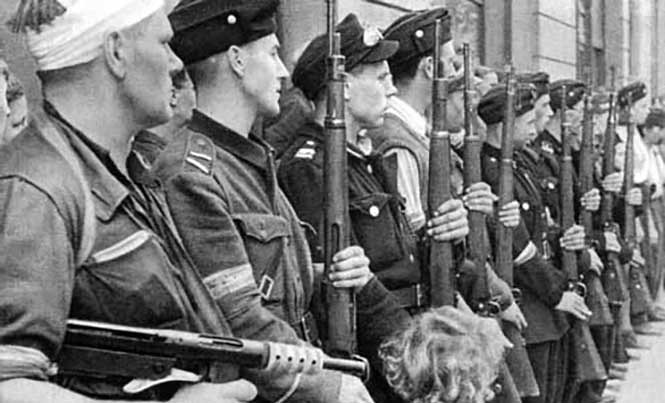
Soldiers from the 1st "Wigry" Company of AK Kilinski Battalion at a funeral in Zgoda Street during the Warsaw Uprising.
Armia Krajowa's forces during the Uprising
Insurgents lack heavy armament: they have assembled a good supply of rifles, submachine guns and pistols - many of them captured from the Germans, some anti-tank weapons and tens of thousands of grenades. The resisters themselves also manufacture flamethrowers, mortars and an armored vehicle. On the other hand, during the combats the members of the AK capture two tanks, a tanker and several armored Germans. Despite the efforts, there are no weapons for all: it is estimated that only one in ten of the insurgents are properly armed.

A German Hetzer tank destroyer captured by the AK during the Warsaw Uprising.
The AK also captures at the beginning of the fighting a warehouse full of German Army and Waffen SS material, so that many insurgents are equipped with "polish" elements of German uniformity, removing Nazi eagles and replacing them with white and red flags and the "orzeł", the Polish white eagle. There are also many fighters who wear Polish Army garments that they have preserved since 1939, especially the typical rogatywka, the Polish military caps of rhomboidal form. Others wear civilian garments of various types, and among the young and children are often the uniforms of the Scout movement, very popular in the country and banned by the Nazis after the invasion. The common element to all AK fighters is the "opaska" or armband with the flag of Poland. Orders are placed for the armbands worn in Operation Burza to carry the Polish eagle, printed in black, next to the initials "WP", by "Wojsko Polskie" (Polish Army), which legally converts this insurgent into soldiers according to stipulated in the Geneva Convention.
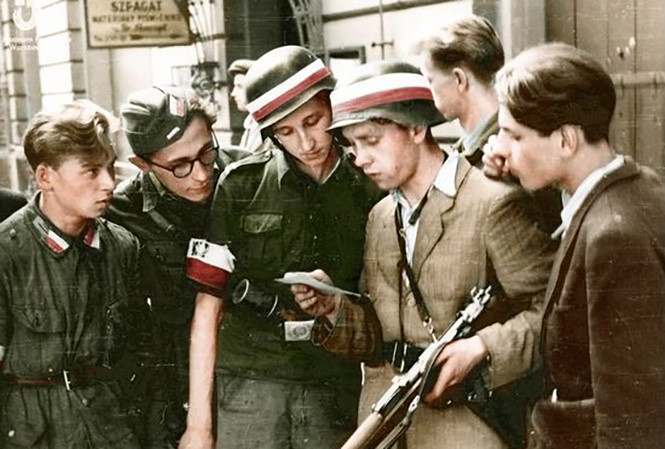
Young soldiers of the AK "Koszta" Company reading a German pamphlet in which they are encouraged to surrender. During the Warsaw Uprising the AK wore German helmets and uniforms, properly "polished".
The foreign participation in the Warsaw Uprising
The AK receives limited support from the Americans and the British, largely because of the difficulties of getting aid by plane, but also because the Western Allies do not want to bother Stalin: the Uprising has been planned, in fact, as an attempt to free itself from the German yoke, but also to avoid falling afterwards under the Soviet yoke, so that Poland becomes, after the war, a democracy as it was before the Nazi invasion of 1939.
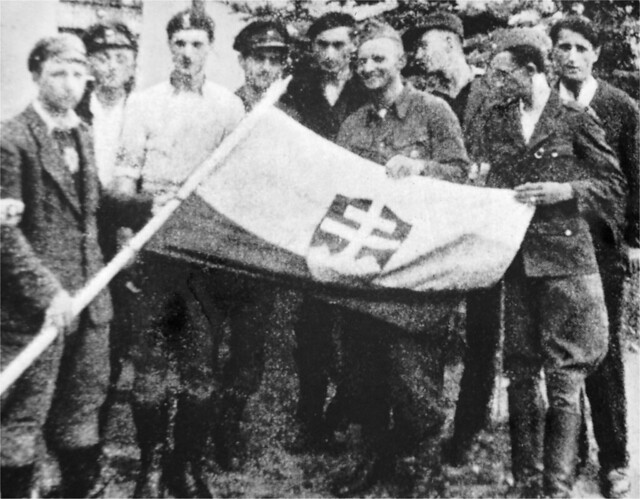
Volunteers of the 535 Slovak Platoon of the 1st Company of the AK "Tur" Battalion, showing a Slovak flag during the Warsaw Uprising.
The AK is also supported by foreign volunteers: some Czech, Slovak, French, Belgian, British, Russian, Azeri, Ukrainian, Hungarian, Georgian, Armenian and even some from Australia and Nigeria are fighting on their side. They are also joined by deserters from the German Army and foreigners who had escaped from prison camps, including more than 300 Jews, some from Greece, the Netherlands, Hungary and Germany. Precisely among the objectives of the AK with this uprising is the liberation of two concentration camps: on August 5, 1944 AK forces attack the Gęsiówka camp, freeing the 360 Jews confined to it (part of which joins the AK) . In this action is used, in fact, one of the Panther tanks captured to the Germans. However, the Polish insurgents failed to liberate Pawiak.
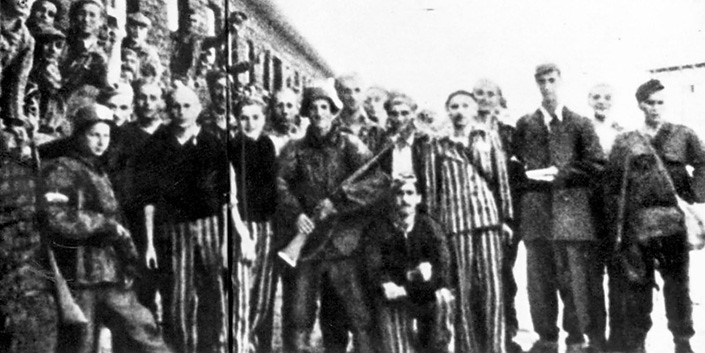
Jewish prisoners from the Gęsiwka concentration camp, after being released by AK soldiers (we see two of them with captured German helmets and bracelets with the Polish flag) on August 5, 1944
German forces and the case of the Hungarian soldiers
The Germans have 16,000 soldiers in Warsaw, including members of the Police and SS. In the environs of the Polish capital there are 90,000 more soldiers, including units formed by Russians, Ukrainians and Azerbaijanis. In the siege mounted by the Germans around the city there are also soldiers of the II Reserve Corps of the Royal Army of Hungary, a country traditionally friendly to Poland, but the Germans withdraw them by realizing that they sympathize with the insurgents: often Provide weapons and food to the Poles. The Hungarian government orders its troops not to join the Poles, but also not to fight them. In spite of these orders, some Hungarian soldiers fight along with the AK and fall in the combats of Warsaw. At present, the remains of seven of them rest in a cemetery in Raszyn, near Warsaw.
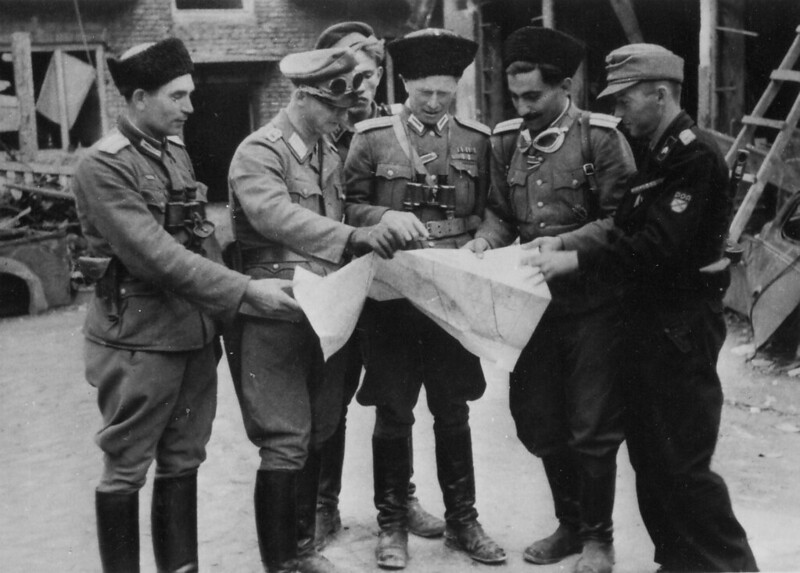
Russian soldiers of SS Sturmbrigade RONA. They fought alongside the Germans and were responsible for some of the worst atrocities perpetrated by that side during the Warsaw Uprising.
The horrendous mass crimes of the Nazis against the Varsovians
As soon as the Warsaw Uprising begins, Hitler gives a clear command: "Turn that city into a lake." The fulfillment of this slogan gives way to a period of horror, embodied in the most atrocious expressions of evil. Already from the first days of the insurrection, the Germans decided to burn down different neighborhoods to deprive the insurgents of their shelter: Mariensztat, in the center, part of the Wola neighborhood and the avenue of Jerusalem are grass of the flames. On 5 August, the Nazi Governor-General of Poland, Hans Frank writes: "Almost every part of the city of Warsaw is on fire." Far from being limited to using its resources in attacking military objectives, the Nazis attack with fury houses, monuments and the Polish cultural heritage: they demolish the Sigismund Column with a cannon, destroy the Tomb of the Unknown Soldier, fly the Royal Castle and burn libraries and archives.
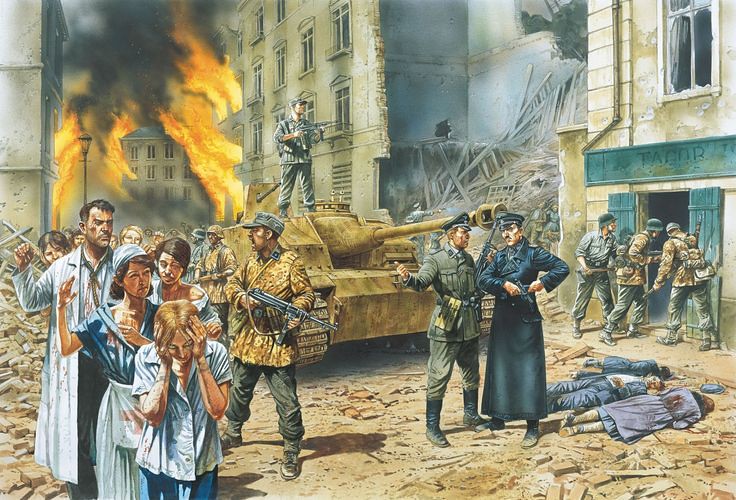
Artistic representation of the Wola Massacre, a Varsovian neighborhood in which the Nazis murdered more than 40,000 people, perpetrating, as in the Ochota district, mass rapes of women and girls.
In addition, German forces, especially the Gestapo and SS, perpetrate mass crimes unprecedented against the Polish population, and display the most repulsive techniques to try to gain advantage over the AK. They use civilians, including children, as human shields, even tying them to their battle tanks so the insurgents will not dare shoot them. In the Varsovian district of Ochota the SS Sturmbrigade RONA, formed by Russians, commit all kinds of crimes against Polish civilians: robberies, fires, murders, tortures and mass rapes, often in groups, of both women and girls. No patients are rescued from the oncology center Maria Sklodowska-Curie Institute: on August 6th that SS unit sets it on fire, lighting the mattresses of the beds of the sick, who are burned alive alive. On August 19 they executed and burned 60 patients who had been evacuated from that hospital. Only 10,000 people are killed in the Ochota district. In the district of Wola more than 40,000 are massacred: the biggest slaughter suffered by Poland in all its history.
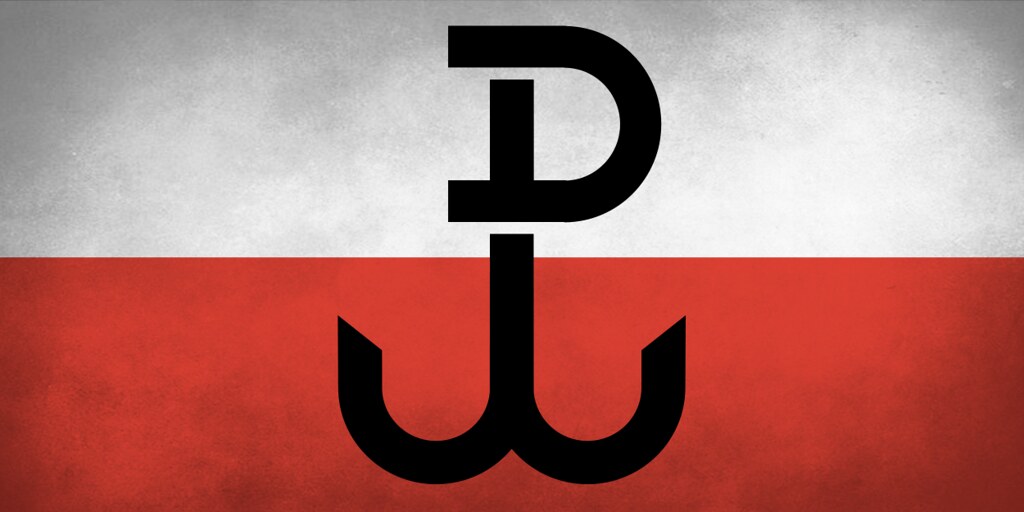
The "Kotwica" (anchor) was the emblem of the Armia Krajowa. It was designed by Anna Smoleńska, murdered in Auschwitz in March 1943. It symbolized the PW acronym Polska Walcząca (Poland in struggle). During the Uprising it was also used for the expression Powstanie Warszawskie (Warsaw Uprising) and Wojsko Polskie (Polish Army). The emblem, persecuted by the Germans during the war, was banned by the communist dictatorship in the post-war period.
The Red Army stops in front of the Vistula: the Stalin's plans
Although initially gaining some mastery over the city center, the AK resents the overwhelming superiority of the Germans in both soldiers and armament. Polish fighters raise barricades and are forced to move through the sewers and undergrounds of the city, which is why many AK soldiers wear a scarf around their necks (to cover their mouths). The mass crimes perpetrated by the Nazis, which have among other aims to undermine the morale of AK soldiers, have the opposite effect: the Poles make their resistance even more furious, given the certainty that if captured or surrendered they will be tortured and murdered. Soviet aid does not arrive. The Red Army had reached the eastern bank of the Vistula River outside Warsaw on 29 July. He will not move from there while the Rise lasts. With the favorable march of the war, Stalin has already begun to develop plans for postwar Eastern Europe: he wants Poland to become a communist puppet state of the USSR, and there is no room for such a project for Polish democrats like the AK. In addition, Stalin has not forgotten that just there, on the banks of the Vistula, the Bolsheviks suffered the humiliating defeat of 1920 at the hands of the Poles. The Soviet dictator, no longer hesitant to sign a secret pact with Hitler in August 1939 to partition Poland with the Nazis, is being taken as a historical revenge.
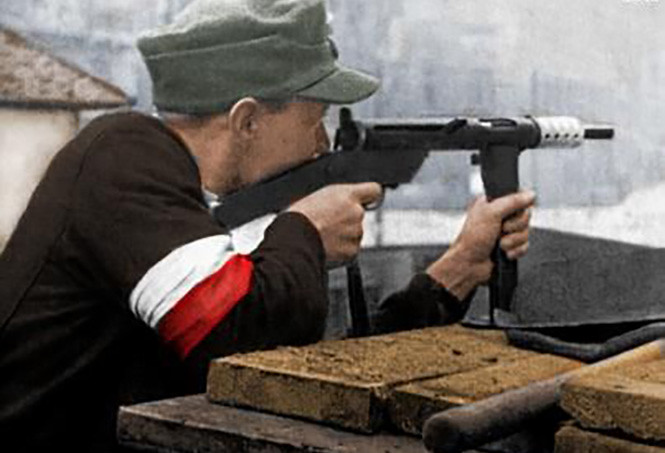
A young AK fighter during the Warsaw Uprising. The "opaska" (armband) with the Polish flag legally identified them as soldiers under the Geneva Convention.
The Polish defeat and the demolition of Warsaw by the Nazis
In the face of Soviet inaction, the Nazis concentrated on suppressing the Polish uprising. They use artillery, engineers and aviation to reduce much of Warsaw to rubble. AK soldiers, who were no longer available of large consignments of arms and ammunition at the beginning of the insurrection, end up facing a desperate situation in the face of the depletion of their reserves, the lack of food and the harsh living conditions in a city turned into Ruins. On October 2, after 63 days of fighting, General Tadeusz Bór-Komorowski signs the surrender before the German Army, which agrees to treat AK soldiers as prisoners of war. In the following days, 15,000 of them are taken to several prison camps in Germany. Another 16,000 AK fighters have died in the fighting in the city. Almost all Warsaw civilians are sent by the Germans to concentration camps and labor camps and to the Ravensbruck, Auschwitz and Mauthausen extermination camps. Between 150,000 and 200,000 Varsovian civilians are killed or perished as a result of the fighting. Between 500,000 and 550,000 civilians are forced to leave their homes.
Once the uprising is suppressed, the Germans use explosives and flamethrowers to erase Warsaw from the map. They destroy more than 900 historic buildings, more than 10,000 buildings, 25 churches - including the Warsaw Cathedral - 14 libraries - including the National Library of Poland - 145 schools, two universities, the Metropolitan Curia Archive, the Power station in Powiśle, Water Pumping Station, Central Train Station, Post Office, Okecie Airport, tram tracks, telegraph lines, and even public trams and buses. The old town is demolished completely, leaving only one building habitable. The German demolition destroyed all Warsaw bridges, 90% of its industrial buildings, 90% of historic buildings (including churches), 95% of its cultural buildings, 90% of hospitals and sanatoria, 70% Of schools, 72% of households, 65% of the electricity network, 100% of telephone exchanges, 70% of telephone lines, 30% of water supply infrastructures, 85% of the streetcar network, 98.5% of public lighting, 60% of the trees and even 60% of the Warsaw Zoo. If in the uprising the Germans had destroyed 25% of the Warsaw buildings, in the subsequent demolition they destroyed 35%.

Marszałkowska street in Warsaw, burned by the Germans during the Uprising. These fires were intended to leave the Polish resistance without shelter.
When the Soviets arrive in Warsaw on January 17, 1945, only 15% of their buildings remain standing: it is a ghost town. The new Communist government provisionally transfers the capital to Lublin, beginning the reconstruction of Warsaw already before the end of the contest. Armia Krajowa fighters released from prison camps at the end of World War II have to choose between exile in the UK and in other countries, or return to Poland and risk communist repression, which is turned against many members of the AK as a threat to the new state. Many former AK soldiers who had fought against the Nazis are executed or sent to Communist concentration camps. Others are pushed into hiding, and not a few decide to continue their work of resistance against the new invaders, being finally captured, tortured and executed, as happened to Witold Pilecki, the Polish officer who infiltrated Auschwitz to inform the Allies about what was happening there. Serve these lines of remembrance and homage for the Poles who fought in that uprising and for those who suffered the brutal repression that followed, both the unleashing by the Nazis and the launching by the Communists.
Cześć i chwała bohaterom!
Honor and glory to the heroes!

Reenactment of the Warsaw Uprising by members of the Poland First to Fight Association in Murcia, Spain, last year (Photo: Sito Lopez Rubio)
Today, the Warsaw Uprising is commemorated with various events in the Polish capital. But what will most surprise any tourist is what happens in Warsaw on August 1, year after year, at five o'clock in the evening, in memory of the fallen in that uprising:
Sirens sound and life stops for a minute.
---
(Header image: Mariusz Kozik. Artistic representation of soldiers of the Aramia Krajowa during the Warsaw Uprising of 1944)
|
Don't miss the news and content that interest you. Receive the free daily newsletter in your email: Click here to subscribe |
- Most read
- Spain will modernize its fleet of firefighting seaplanes and buy seven new DHC-515s
- The ten oldest national flags in the world that are still in use today
- Lenin: numbers, data and images of the crimes of the first communist dictator
- Sierra Army Depot, a huge United States base with hundreds of Abrams tanks stored
- United States' last Hueys: Vietnam-era veterans still flying in the US Air Force
- A former secret submarine base in Estonia and its important role in the Cold War
- The drift of the anti-Western right: yesterday Moscow, now Tehran, tomorrow Pyongyang?

 ES
ES





Opina sobre esta entrada: